Introduction
Artificial intelligence (AI) has the potential to revolutionize various industries, including environmental conservation. By using AI technologies, researchers and conservationists can gather and analyze vast amounts of data to make more informed decisions about protecting the environment and wildlife. Ethical AI in environmental conservation focuses on using these technologies responsibly to enhance sustainability and resilience in the face of climate change and other environmental challenges.
Enhancing Sustainability with Ethical AI
One of the key ways that ethical AI can enhance sustainability in environmental conservation is by improving data collection and analysis. AI algorithms can process large amounts of data from sources such as satellites, drones, and wildlife sensors to identify patterns and trends that would be impossible for humans to detect. This data can then be used to make more accurate predictions about environmental changes and develop better conservation strategies.
For example, AI can be used to analyze satellite imagery to monitor deforestation rates in real-time, allowing conservationists to respond more quickly to illegal logging activities. AI can also be used to track the movements of endangered species, helping researchers to better understand their behavior and habitat requirements. By using AI to gather and analyze data, conservationists can make more informed decisions about how to protect the environment and wildlife.
In addition to improving data analysis, ethical AI can also help to optimize resource allocation in environmental conservation. By using AI algorithms to prioritize conservation efforts, organizations can ensure that limited resources are used most effectively. For example, AI can be used to identify the areas that are most at risk from climate change and prioritize conservation efforts in these regions.
Another way that ethical AI can enhance sustainability in environmental conservation is by facilitating collaboration and knowledge sharing. AI technologies can be used to create platforms for sharing data and best practices among conservation organizations, allowing them to work together more effectively towards common goals. By breaking down silos and promoting collaboration, AI can help to accelerate progress towards sustainable environmental practices.
Enhancing Resilience with Ethical AI
In addition to enhancing sustainability, ethical AI can also help to build resilience in the face of environmental challenges. Climate change is already having a significant impact on the environment, with rising temperatures, changing weather patterns, and increasing frequency of natural disasters. By using AI technologies, conservationists can better understand these changes and develop strategies to adapt to them.
For example, AI can be used to predict the impact of climate change on wildlife populations and ecosystems, allowing conservationists to develop strategies to help species survive in changing environments. AI can also be used to model the spread of diseases in wildlife populations, helping to prevent outbreaks that could have devastating consequences for biodiversity.
Ethical AI can also help to build resilience by improving early warning systems for natural disasters. By analyzing data from sensors and satellites, AI algorithms can predict when and where disasters such as floods or wildfires are likely to occur, allowing communities to prepare and evacuate in advance. By using AI to improve disaster response and recovery efforts, conservationists can help to minimize the impact of these events on the environment and wildlife.
FAQs
Q: How can ethical AI be used to monitor and protect endangered species?
A: Ethical AI can be used to track the movements of endangered species, analyze their behavior, and identify threats to their survival. By using AI to gather and analyze data, conservationists can develop strategies to protect these species and their habitats.
Q: What are the ethical considerations when using AI in environmental conservation?
A: When using AI in environmental conservation, it is important to consider issues such as data privacy, bias, and transparency. Conservationists should ensure that the data used to train AI algorithms is collected ethically and that the algorithms themselves are fair and transparent.
Q: How can AI help to combat illegal wildlife trafficking?
A: AI can be used to analyze data from sources such as wildlife sensors and social media to identify patterns of illegal wildlife trafficking. By using AI to track the movement of illegal wildlife products, conservationists can better understand the networks involved in this illegal trade and develop strategies to combat it.
Q: How can AI technologies be used to improve sustainable agriculture practices?
A: AI technologies can be used to analyze data on soil health, weather patterns, and crop yields to optimize agricultural practices. By using AI to make more informed decisions about when and where to plant crops, farmers can reduce waste and minimize the environmental impact of agriculture.
Conclusion
Ethical AI has the potential to revolutionize environmental conservation by enhancing sustainability and resilience in the face of climate change and other environmental challenges. By using AI technologies responsibly, conservationists can gather and analyze vast amounts of data to make more informed decisions about protecting the environment and wildlife. Through improved data analysis, resource allocation, collaboration, and knowledge sharing, ethical AI can help to accelerate progress towards sustainable environmental practices. By building resilience through early warning systems, disaster response, and strategies to help species adapt to changing environments, ethical AI can help to minimize the impact of environmental challenges on the environment and wildlife.

